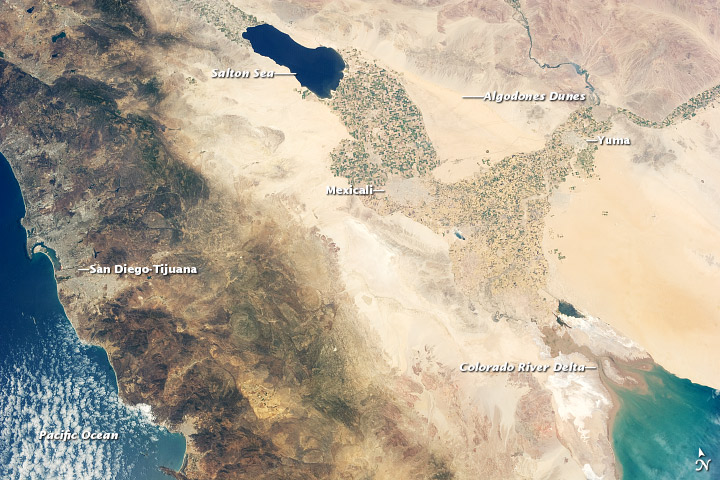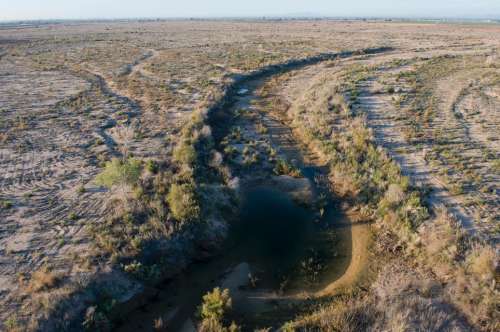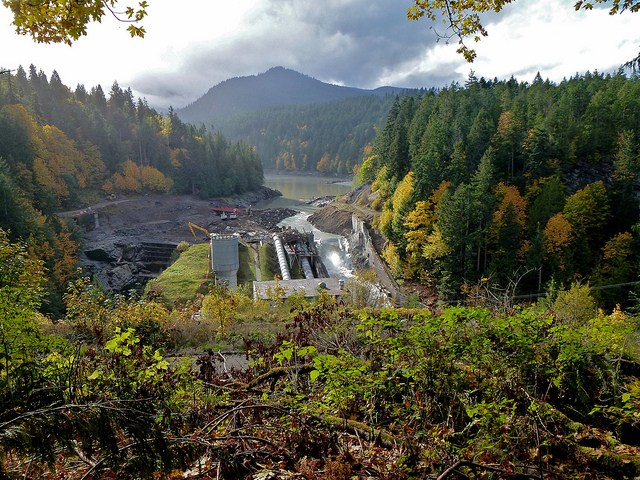River Flow By Design: Environmental Flows Support Ecosystem Services In Rivers Natural And Novel
The October 2014 issue of ESA Frontiers spotlights river management in the Anthropocene
“Dawn on the Delta was whistled in by Gambel quail, which roosted in the mesquites overhanging camp. When the sun peeped over the Sierra Madre, it slanted across a hundred miles of lovely desolation, a vast flat bowl of wilderness rimmed by jagged peaks. On the map the Delta was bisected by the river, but in fact the river was nowhere and everywhere, for he could not decide which of a hundred green lagoons offered the most pleasant and least speedy path to the Gulf. So he traveled them all, and so did we. He divided and rejoined, he twisted and turned, he meandered in aswsome jungles, he all but ran in circles, he dallied with lovely groves, he got lost and was glad of it, and so were we.”
-Aldo Leopold, “The Green Lagoons,” A Sand County Almanac with Essays on Conservation from Round River. Oxford University Press 1966. pp 150.
For Aldo Leopold, an adventure that shone in memory could not be revisited in life without losing its luster. “For this reason, I have never gone back to the Delta of the Colorado since my brother and I explored it, by canoe, in 1922,” he wrote in his 1944 account of the trip, “The Green Lagoons.” By then it was already too late to go back; the delta was dying. The Hoover Dam and and Imperial Valley projects already sat over the river upstream, delivering power and water to California, Colorado, and Nevada, and holding back the water, silt, and spring floods that had created the rich density of delta life he remembered. That year the United States and Mexico signed a treaty for the “Utilization of Waters of the Colorado and Tijuana Rivers and of the Rio Grande” that allocated 90 percent of the river’s water to the States, 10 percent to Mexico, and none to the delta. Today, the river supports 40 million people, but not the old ecosystems of its lower reaches.
Last spring, the Colorado River reached its delta for the first time in 16 years, flowing into Pacific Ocean at the Gulf of California after wetting 70 miles of long-dry channels through the Sonoran Desert. The planned 8-week burst of water from Mexico’s Morelos Dam on the Arizona-Mexico border was part of a pilot program included in the Minute 319 amendment to the 1944 treaty, the culmination of years of diplomatic negotiations between the U.S. and Mexico and campaigning from scientists and conservation organizations. Now ecologists wait to see how the short drink of water will affect the parched landscape.

Tides flow backwards up the dry channels of the Colorado River delta, as seen in an astronaut photo taken June 21, 2013. Prior to the construction of the Hoover Dam and other large water projects on the Colorado, the delta estuary supported a great diversity of species in 3,000 square miles (7,700 square kilometers) of braided channels and lagoons. Now, the river typically runs dry a few miles south of the Arizona-Mexico border. In the spring of 2014, an experimental “pulse” of 105,000 acre-feet (130 million cubic meters) of water was released from the lowest dam on the river in an effort to recover some the lost services provided by the lower Colorado ecosystems. Credit, NASA. (Click image to enlarge it).
This year’s spring pulse held less than 1 percent of the volume of the Colorado’s annual spring floods before the construction of ten major dams and diversions to municipalities, industry, and agriculture. A return of the lush Colorado delta of the 1920s will not be possible. But there is hope that periodic flows will bring back willow, mesquite, and cottonwood trees, revive insects and dormant crustaceans, give respite to birds migrating on the Pacific Flyway, and ease strains on fisheries in the Sea of Cortez (Gulf of California).

The Colorado River runs dry on the U.S./Mexico border 2 miles below the Morelos Dam. Credit Pete McBride, USGS.
Learn more:
- Sonoran Institute photo album:The Colorado River’s Historic Connection with the Sea (May 2014)
- Acres of clams: with the loss of seasonal silt deposition at the Colorado River delta, mountains of gleams clam shells are revealed along the coast. Living clams have become rare in the Gulf of California with the changes in the delta.
- Landsat image gallery for 2014 pulse flow on the Colorado
- “The Day we Set the Colorado River Free.” A journey (with photos) by Rowan Jacobsen for Outside Magazine, 10 June 2014.
Environmental flows for natural, hybrid, and novel riverine ecosystems in a changing world
There are two primary ways to achieve “environmental flows” of water necessary to sustain river ecosystems, write Mike Acreman, of the UK’s Centre for Ecology & Hydrology, and colleagues in a review published this month in Frontiers in Ecology and the Environment: controlled releases like the recent experiment on the Colorado that are designed with specific objectives for ecology and ecosystem services in mind and hands-off policies that minimize or reverse alterations to the natural flow of the river.
For rivers like the Colorado, already much altered and bearing heavy demands from many different user groups, a “designer” approach is more practical than attempting to return the river closer to its natural, pre-development state, say the authors. Designers work to create a functional ecosystem or support ecosystem services under current conditions, rather than recreate a historical ecosystem.
Achieving ecological objectives requires planning beyond minimum flows and indicator species to encompass seasonal floods and slack flows and a holistic look at the plants, fish, fungi, birds and other life inhabiting the river, its banks and its marshes. Managers must plan to turn on the taps when ecosystems can capitalize on the flow, lest water releases do more harm than good. Several decades of applied research guided the planning for the engineered “spring flood” on the lower Colorado this year, which was timed for the germination of native trees.
Rebirth of the Elwha River

The Elwha River pours through the remains of the Elwha Dam in Washington State’s Olympic National Park on October 23, 2011. The former reservoir beds have recovered quickly and salmon and steelhead have returned after demolition of the two dams on the river. Credit Kate Benkert, USFWS.
For rivers with fewer economic and social demands, restoration guided by historical records of the natural dynamics of the river can be an effective restoration strategy, say Acreman and colleagues. To preserve species and get the maximum value from ecosystem services, river systems need to fluctuate in natural rhythms of volume, velocity, and timing ( to put it very simplistically).
At the end of the twentieth century, Washington State decided that the water of the Elwha River would be most valuable flowing freely through Olympic National Park to the Pacific at the Strait of Juan de Fuca, supporting salmon, trout, clams, and tourism. Habitat and eroded coastline are recovering at an astonishing pace only one year after the demolition of two dams freed the river, as Noreen Parks reports for her news story “Rebirth of the Elwha River” in ESA Frontier’s October Dispatches.
- Glines Dam construction (1927 archival photos) Flickr set
- Elwha restoration Flickr set by James Wengler
Rivers of the Anthropocene?
Outside protected wilderness, the Elwha’s story may be more of an anomaly than a blueprint for future river restoration projects. As non-native species, land development, and climate change remodel river ecosystems, it is no longer easy to define what is “natural” for river systems. But heavily used, regulated, and altered rivers have ecological value.
“The future of freshwater biodiversity is inextricably linked to land and water infrastructure management,” writes N LeRoy Poff of Colorado State University in his guest editorial for ESA Frontiers, in which he contemplates whether rivers have changed so much that we need to rethink some of our conceptions about restoration.
“We are rapidly entering an era where restoration interventions will be guided less by statistical deviations from historical reference conditions and more by “process-based” understanding of organism–environment relationships,” he writes.
- Environmental flows for natural, hybrid, and novel riverine ecosystems in a changing world. (2014) Mike Acreman, Angela H Arthington, Matthew J Colloff, Carol Couch, Neville D Crossman, Fiona Dyer, Ian Overton, Carmel A Pollino, Michael J Stewardson, and William Young. Frontiers in Ecology and the Environment 12: 466–473. http://dx.doi.org/10.1890/130134
- “Rebirth of the Elwha River.” (2014) Noreen Parks. Dispatches. Frontiers in Ecology and the Environment 12: 428–432. http://dx.doi.org/10.1890/1540-9295-12.8.428
- Rivers of the Anthropocene? (2014) N LeRoy Poff. Frontiers in Ecology and the Environment 12: 427–427.http://dx.doi.org/10.1890/1540-9295-12.8.427